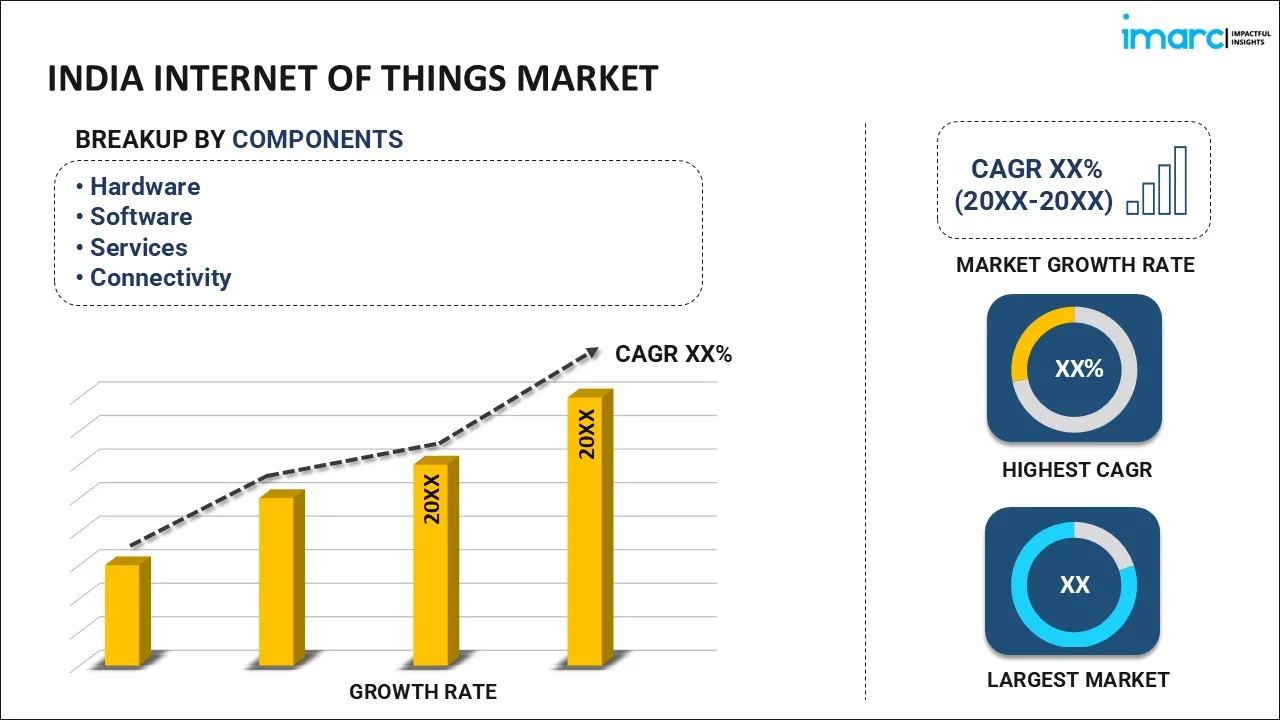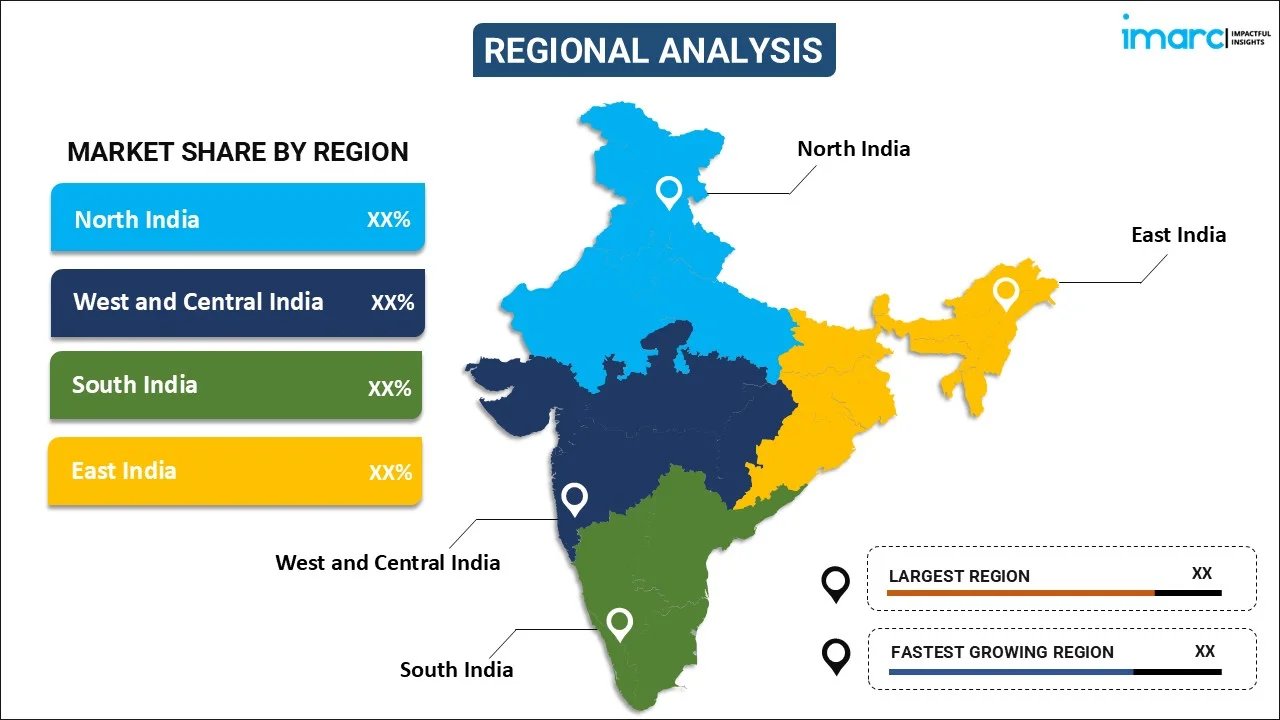
India Internet of Things Market Report by Component (Hardware, Software, Services, Connectivity), Application (Smart Home, Smart Wearables, Smart Cities, Smart Grid, IoT Industrial Internet, IoT Connected Cars, IoT Connected Healthcare, and Others), Vertical (Healthcare, Energy, Public and Services, Transportation, Retail, Individuals, and Others), and Region 2025-2033
Market Overview:
The India internet of things market size reached USD 1.4 Billion in 2024. Looking forward, IMARC Group expects the market to reach USD 3.6 Billion by 2033, exhibiting a growth rate (CAGR) of 10.2% during 2025-2033.
|
Report Attribute
|
Key Statistics
|
|---|---|
|
Base Year
|
2024
|
|
Forecast Years
|
2025-2033
|
|
Historical Years
|
2019-2024
|
|
Market Size in 2024
|
USD 1.4 Billion |
|
Market Forecast in 2033
|
USD 3.6 Billion |
| Market Growth Rate 2025-2033 | 10.2% |
The internet of things (IoT) is a network of interrelated and internet-connected objects that can collect and transmit data over a wireless network without human intervention. It relies on machine learning (ML) or artificial intelligence (AI) technologies to analyze data and offer businesses access to advanced analytics by collecting data on customer behavior. It assists in making informed decisions, increasing security by monitoring digital and physical infrastructure for optimizing performance, improving efficiency and reducing safety risks. As a result, IoT finds extensive applications in retail, government, healthcare, manufacturing, agriculture, and transportation sectors across India.
India Internet of Things Market Trends:
The growing utilization of blockchain technology to enhance security, enable the inclusion of low-value devices, and simplify device management represents one of the key factors driving the market in India. Moreover, there is a rise in the number of startups in the country due to consolidation activities, massive funding, technological advancements, and a burgeoning domestic market. This, along with the expanding ecosystem wherein sensors and devices are connected to a network, is propelling the growth of the market. In addition, there is an increase in the usage of affordable devices with cloud computing. This, coupled with the rising trend of connected homes and buildings, is catalyzing the demand for IoT in the country. Besides this, the growing employment of IoT in the healthcare industry for real-time monitoring of patients, enhancing connectivity, and altering the doctor-patient relationship is positively influencing the market. Additionally, the Government of India is extensively investing in digital infrastructure to promote flagship programs, such as Make in India and Digital India, which are offering lucrative growth opportunities to industry investors.
Key Market Segmentation:
IMARC Group provides an analysis of the key trends in each sub-segment of the India internet of things market report, along with forecasts at the country and regional level from 2025-2033. Our report has categorized the market based on component, application and vertical.
Breakup by Component:

- Hardware
- Software
- Services
- Connectivity
Breakup by Application:
- Smart Home
- Smart Wearables
- Smart Cities
- Smart Grid
- IoT Industrial Internet
- IoT Connected Cars
- IoT Connected Healthcare
- Others
Breakup by Vertical:
- Healthcare
- Energy
- Public and Services
- Transportation
- Retail
- Individuals
- Others
Breakup by Region:

- North India
- West and Central India
- South India
- East India
Competitive Landscape:
The competitive landscape of the industry has also been examined along with the profiles of the key players.
Report Coverage:
| Report Features | Details |
|---|---|
| Base Year of the Analysis | 2024 |
| Historical Period | 2019-2024 |
| Forecast Period | 2025-2033 |
| Units | Billion USD |
| Segment Coverage | Component, Application, Vertical, Region |
| Region Covered | North India, West and Central India, South India, East India |
| Customization Scope | 10% Free Customization |
| Post-Sale Analyst Support | 10-12 Weeks |
| Delivery Format | PDF and Excel through Email (We can also provide the editable version of the report in PPT/Word format on special request) |
Key Questions Answered in This Report
The India Internet of Things market was valued at USD 1.4 Billion in 2024.
We expect the India Internet of Things market to exhibit a CAGR of 10.2% during 2025-2033.
The increasing deployment of the Internet of Things across several industries, including transportation, retail, manufacturing, healthcare, agriculture, etc., as it helps in making informed decisions, improving productivity, reducing safety risks, etc., is primarily driving the India Internet of Things market.
The sudden outbreak of the COVID-19 pandemic has led to the rising adoption of the Internet of Things, owing to the growing demand for automation to remotely enhance security and operational efficiency, during the lockdown scenario across the nation.
Based on the vertical, the India Internet of Things market can be bifurcated into healthcare, energy, public and services, transportation, retail, individuals, and others. Currently, the energy sector accounts for the majority of the total market share.
On a regional level, the market has been classified into North India, West and Central India, South India, and East India, where South India currently dominates the India Internet of Things market.
Need more help?
- Speak to our experienced analysts for insights on the current market scenarios.
- Include additional segments and countries to customize the report as per your requirement.
- Gain an unparalleled competitive advantage in your domain by understanding how to utilize the report and positively impacting your operations and revenue.
- For further assistance, please connect with our analysts.
 Inquire Before Buying
Inquire Before Buying
 Speak to an Analyst
Speak to an Analyst
 Request Brochure
Request Brochure
 Request Customization
Request Customization




.webp)




.webp)












